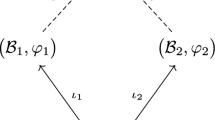Abstract
In this paper we introduce and study weakly linear systems, i.e. systems consisting of matrix inequalities Eqs. 17–20, over the max-plus quantale which is also known as complete max-plus algebra. We prove the existence of the greatest solution contained in a given matrix X0, and present a procedure for its computation. In the case of weakly linear systems consisting of finitely many matrix inequalities, when all finite elements of matrices X0, As and Bs, s ∈ I are integers, rationals or particular irrationals and a finite solution exists, the procedure finishes in a finite number of steps. If in that case an arbitrary finite solution is given, a lower bound on the number of computational steps is calculated. Otherwise, we use our algorithm to compute approximations to finite solutions.
Similar content being viewed by others
References
Akian M, Gaubert S, Guterman A (2012) Tropical polyhedra are equivalent to mean payoff games. Int J Algebr Comput 22(1):125001
Allamigeon X, Gaubert S, Goubault E (2013) Computing the vertices of tropical polyhedra using directed hypergraphs. Discrete Comput Geom 49:247–279
Baccelli F, Cohen G, Olsder G, Quadrat J (1992) Synchronization and Linearity. John Wiley & Sons, New York
Baranga A (1991) The contraction principle as a particular case of Kleene’s fixed point theorem. Discr Math 98:75–79
Butkovič P (2003) Max-algebra: the linear algebra of combinatorics? Linear Algebra Appl 367:313–335
Butkovič P (2010) Max-linear Systems: Theory and Algorithms. Springer-Verlag, London
Butkovič P, Hegedüs G (1984) An elimination method for finding all solutions of the system of linear equations over an extremal algebra. Ekonom Mat Obzor 2(20):203–215
Cuninghame-Green RA (1979) Minimax Algebra. Lecture Notes in Econom. and Math. Systems Vol. 166. Springer-Verlag, Berlin
Cuninghame-Green RA, Butkovič P (2003) The equation A ⊗ x = B ⊗ y over (max,+). Theor Comput Sci 293:3–12
Cuninghame-Green RA, Cechlarova K (2003) Soluble approximation of linear systems in max-plus algebra. Kybernetika 39:137–141
Ćirić M, Ignjatović J, Bašić M, Jančić I (2014) Nondeterministic automata: equivalence, bisimulations, and uniform relations. Inf Sci 261:185–218
Ćirić M, Ignjatović J, Damljanović N, Bašić M (2012a) Bisimulations for fuzzy automata. Fuzzy Sets Syst 186:100–139
Ćirić M, Ignjatović J, Jančić I, Damljanović N (2012b) Computation of the greatest simulations and bisimulations between fuzzy automata. Fuzzy Sets Syst 208:22–42
Ćirić M, Stamenković A, Ignjatović J, Petković T (2007) Factorization of fuzzy automata. In: Csuhaj-Varju E, Ésik Z (eds) FCT 2007, Lecture Notes in Computer Science, vol 4639, pp 213–225
Ćirić M, Stamenković A, Ignjatović J, Petković T (2010) Fuzzy relation equations and reduction of fuzzy automata. J Comput Syst Sci 76:609–633
Cohen G, Dubois D, Quadrat J-P, Viot M (1985) A linear-system-theoretic view of discrete-event processes and its use for performance evaluation in manufacturing. IEEE T Automat Contr 30:210–220
Damljanović N, Ćirić M, Ignjatović J (2014) Bisimulations for weighted automata over an additively idempotent semiring. Theor Comput Sci 534:86–100
De Shutter B (2000) On the ultimate behavior of the sequence of consecutive powers of a matrix in the max-plus algebra. Linear Algebra Appl 30:103–117
De Schutter B, van den Boom T (2008) Max-plus algebra and max-plus linear discrete event systems: An introduction. In: Proceedings of the 9th international workshop on discrete event systems. Göteborg, Sweden, pp 36–42
Heidergott B, Olsder GJ, van der Woude J (2005) Max plus at work: Modeling and analysis of synchronized systems: A course on max-plus algebra. Princeton University Press, Princeton
Gaubert S (1997) Methods and Applications of (max,+) Linear Algebra. LNCS 500. Springer-Verlag, Berlin, pp 261–282
Gaubert S, Sergeev S (2013) The level set method for the two-sided max-plus eigenproblem. Discrete Event Dyn Syst 23:105–134
Ignjatović J, Ćirić M (2012) Weakly linear systems of fuzzy relation inequalities and their applications: A brief survey. Filomat 26(2):207–241
Lahaye S, Lai A, Komenda J, Boimond J-L (2020) A contribution to the determinization of max-plus automata. Discrete Event Dyn Syst 30:155–174. Springer Verlag
Ignjatović J, Ćirić M, Bogdanović S (2010) On the greatest solutions to weakly linear systems of fuzzy relation inequalities and equations. Fuzzy Sets Syst 161:3081–3113
Ignjatović J, Ćirić M, Damljanović N, Jančić I (2012) Weakly linear systems of fuzzy relation inequalities: The heterogeneous case. Fuzzy Sets Syst 199:64–91
Jančić Z, Micić I, Ignjatović J, Ćirić M (2016) Further improvements of determinization methods for fuzzy finite automata. Fuzzy Sets Syst 301:79–102
Krivulin N (2011) An algebraic approach to multidimensional minimax location problems with Chebyshev distance. WSEAS Trans Math 10:191–200
Krivulin N (2020) Complete solution of tropical vector inequalities using matrix sparsification. Appl Math 65(6):755–775
Lorenzo E, de la Puente MJ (2011) An algorithm to describe the solution set of any tropical linear system A ⊙ x = B ⊙ x. Linear Algebra Appl 435(4):884–901
Minguzzi E (2012) Quasi-pseudo-metrization of topological preordered spaces. Topol Appl 159:2888–2898
Smyth MB, Plotkin GD (1982) The category-theoretic solution of recursive domain equations. SIAM J Comput 11:761–783
Stamenković A, Ćirić M, Bašić M (2018) Ranks of fuzzy matrices. Applications in state reduction of fuzzy automata. Fuzzy Sets Syst 333:124–139
Stamenković A, Ćirić M, Ignjatović J (2014) Reduction of fuzzy automata by means of fuzzy quasi-orders. Inf Sci 275:168–198
Roman S (2008) Lattices and Ordered Sets. Springer, New York
Sergeev S, Wagneur E (2011) Basic solutions of systems with two max-linear inequalities. Linear Algebra Appl 435(7):1758–1768
Wagneur E, Truffet L, Faye F, Thiam M (2009) Tropical cones defined by max-linear inequalities. In: Litvinov GL, Sergeev SN (eds) Tropical and idempotent mathematics. contemporary mathematics. AMS Providence, vol 495, pp 351–366
Author information
Authors and Affiliations
Corresponding author
Additional information
Publisher’s note
Springer Nature remains neutral with regard to jurisdictional claims in published maps and institutional affiliations.
The first two authors are supported by Ministry of Education, Science and Technological Development, Republic of Serbia, Contract No. 451-03-68/2020-14/200124.
Rights and permissions
About this article
Cite this article
Stamenković, A., Ćirić, M. & Djurdjanović, D. Weakly linear systems for matrices over the max-plus quantale. Discrete Event Dyn Syst 32, 1–25 (2022). https://doi.org/10.1007/s10626-021-00342-4
Received:
Accepted:
Published:
Issue Date:
DOI: https://doi.org/10.1007/s10626-021-00342-4



